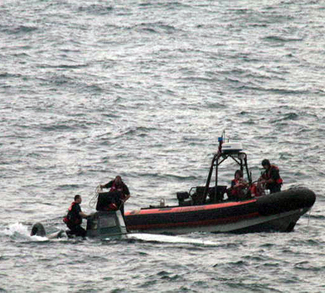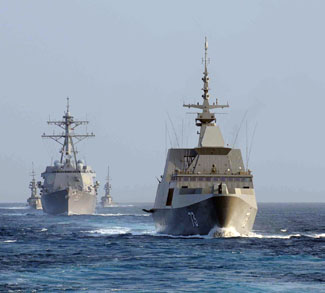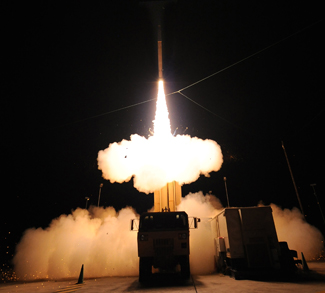Background
For several decades, international agencies such as Ameripol, the International Association of Chiefs of Police, and the UNODC have worked incessantly with domestic law enforcement agencies to seize illicit drugs, arrest traffickers, and reduce the flow of narcotics into the United States and other countries. Through a series of bilateral, multilateral, regional, and global accords, governments and their militaries have increasingly cooperated in multiple anti-drug measures and operations designed to mitigate the threats presented by drug traffickers.
Transnational organized crime (TOC) has become an obstinate issue in international affairs. Organized crime affects the global economy and has the capacity to undermine the rule of law and governance of nations. Sustainable development, public health, and public safety are imperiled by the criminal activities of drug trafficking organizations.
In the United States, the Department of the Treasury, the Drug Enforcement Agency, U.S. Coast Guard, U.S. Navy, U.S. Customs and Border Protection (CBP) Office of Air and Marine (AMO), Department of Homeland Security, and Department of Defense have designed comprehensive strategies aimed at addressing the corrosive effects of the illegal drug trade, including money laundering, corruption, terrorism, human trafficking, and economic distortion. For instance, the Department of the Treasury, through the Office of Terrorism and Financial Intelligence (TFI), combats all aspects of money laundering committed by criminal organizations and terrorists. The Joint Interagency Task Force (JIATF) South and the U.S. Southern Command have been conducting interagency detection and monitoring operations, and developed tactical approaches for the interdiction of illicit trafficking and the mitigation of other narco-terrorist threats in support of national and partner nation security.
The illicit drug trade is a profitable business. According to a 1997 World Drug Report published by the United Nations Office on Drugs and Crime, illicit drugs generated approximately $400 billion per year of total revenue. At that time, it was estimated that illicit drugs represented approximately 8 percent of total international trade. Since then, authorities have made numerous interdictions and arrests. Yet in 2015, the UNODC reported that the bulk weight (tons) of seized cocaine in the Americas in the year 2013 was at a level similar to the one reported in the year 2006. This is particularly concerning when we consider the resolute efforts made by law enforcement agencies during the past two decades.
The Rise of Narco-Submarines
During the late 1980s, Colombian drug cartels dominated the flow of cocaine into the United States and Europe. Through the use of go-fast boats and small planes, the Medellin Cartel and Cali Cartel delivered their illicit product throughout the Americas. However, the increased effectiveness of law enforcement agencies in detecting and seizing aircraft and boats, forced drug traffickers to consider developing alternative means for transporting and delivering narcotics to their intended destinations.
Drug cartels in Colombia began to experiment with narco submarines in the early 1990s. They tried to counteract ameliorated radar and communication technology held by militaries and law enforcement. Accordingly, drug traffickers made attempts to improve the design and operational capabilities of their narco submarines in order to gain the ability to further evade detection and seizure.
After the collapse of the Medellin and Cali Cartels, other criminal organizations such as FARC (Fuerzas Armadas Revolucionarias de Colombia) continued to invest in narco submarine technology. The design and engineering of narco submarines continued to evolve during the late 1990s and 2000s. Over time, these vessels became capable of self-propulsion and full submersion. They were also able to travel longer distances while having an increased carrying capacity. Simultaneously, law enforcement developed advanced radar technology. And it was in the mid-2000s when authorities noticed great similarities in the design of the vessels they were seizing. These vessels resembled go fast-boats and were reconfigured so that they would sit just above the water line. This type of narco submarines became known as low profile vessels (LPVs).
During the past few years, U.S. authorities working alongside other Latin American militaries began to seize vessels – actual submarines – that were capable of full submersion. Many of these narco submarines were capable of reaching speeds of 15 miles per hour while carrying up to 10 tons of narcotics. Some of these newer models were powered by 350 horse-powered diesel engines and carried large fuel tanks which allowed them to travel a range of up to 2,000 nautical miles. Because the majority of their structure was made out of fiberglass and they could navigate below the sea surface, these vessels became almost impossible to detect via sonar or radar. Many of these vessels were built with upper lead shielding which helps minimize their heat signature and thus they can evade infrared sensors. Also, several models had piping along the bottom to allow the water to cool the exhaust as the vessel moves, making it even less vulnerable to infrared detection. These vessels also have ballast tanks and are equipped with a satellite global positioning system that aids their navigation.
Narco Submarines Today
Drug cartels have grown increasingly strategic and resourceful. Their vast profits allow them to invest in enhanced transportation technologies and innovative methods of evading capture. In recent years, narco submarines have been used by FARC and other criminal organizations (Los Rastrojos, Urabeňos) throughout the Western Hemisphere to transport narcotics from South America to Central and North America. These vessels travel usually from Western Colombia via the Pacific Ocean towards Central America and Mexico. They are also deployed from Northern Colombia via the Caribbean towards Central America and small islands located throughout the Caribbean region. However, the number of narco submarines has apparently risen as there are reports of seized narco submarines in Venezuela, Guyana, Ecuador, and Brazil.
Since 2012, Operation Martillo has led to the seizure of almost 700 metric tons of cocaine, detained over 1,800 suspects and 581 vessels and aircraft. Nonetheless, in spite of the success of these integrated efforts, maritime drug smuggling activities continue.
It is worth taking into consideration that the UNODC’s 2015 World Drug Report recently reported:
“While maritime trafficking is not the most widely used mode of smuggling drugs, law enforcement operations at sea have potentially the greatest impact as the average volumes of seizures is proportionally higher. In the period 2009-2014, for instance, the average for each seizure by sea was 365kg, while by land (road and rail) it was 107kg and by air 10kg.”
This suggests that law enforcement should continue to focus on maritime interdiction and cooperation with allies. Collaboration is imperative to improving the efficiency and effectiveness of ongoing interdiction efforts. In order to adequately disrupt drug trafficking operations in the Americas, agencies must improve their exchange of intelligence, share best practices, and invest in various types of technology.
Challenges to Countering Narco Submarines
In July 2011, the National Security Council released its Strategy to Combat Transnational Organized Crime. The report explains that transnational organized crime (TOC) poses a significant and growing threat to national and international security. Moreover, TOC yields ominous implications for public safety, health, democratic institutions, and economic stability across the globe. The report indicates that criminal networks are expanding and diversifying their activities, which in turn leads to the amplified convergence of threats to national security.
Among the key priority areas that are included in the Council’s strategy are: protecting the financial system and strategic markets against transnational organized crime; strengthening interdiction, investigations, and prosecutions; disrupting drug trafficking and its facilitation of other transnational threats; and building international capacity, cooperation, and partnerships.
Following these aims, the U.S. Coast Guard has been collaborating with the U.S. Navy and other agencies. These interagency partnerships have utilized military surveillance aircraft and nuclear fast attack submarines to search for vessels carrying narcotics. Furthermore, the Coast Guard has also been using HC-130 Hercules aircraft which provide surveillance and tracking of drug trafficking vessels.
Notwithstanding the increased cooperation and integration of activities between law enforcement agencies, governments, and other stakeholders, drug trafficking organizations continue to propagate threats to U.S. national security and the security of other countries in Latin America and the Caribbean. Just to complicate matters a bit more, budget cuts in the U.S. have led to limited funding for maritime surveillance, interception, and seizure efforts.
In March 2015, Marine General John Kelly, commander of (SOUTHCOM) U.S. Southern Command, testified before the Armed Services Committee about the security challenges that the United States faces. In his testimony, General Kelly noted:
“[Our friends across the region] are frustrated by what they perceive as the low prioritization of Latin America on our national security and foreign policy agendas, which is especially puzzling given the shared challenge of transnational organized crime……. The tentacles of global networks involved in narcotics and arms trafficking, human smuggling, illicit finance, and other types of illegal activity reach across Latin America and the Caribbean and into the United States, yet we continue to underestimate the threat of transnational organized crime at significant and direct risk to our national security and that of our partner nations.”
General Kelly added the following statement about terrorist organizations that are part of the global criminal network:
“As I stated last year, terrorist organizations could seek to leverage those same smuggling routes to move operatives with intent to cause grave harm to our citizens or even bring weapons of mass destruction into the United States.”
General Kelly also pointed out that reduced funding has limited SOUTHCOM’s activities:
“as the lowest priority Geographic Combatant Command, ‘doing less with less’ has a disproportionate effect on our operations, exercises, and engagement activities…… we are managing to keep the pilot light of U.S. military engagement on in the region — but just barely.”
In similar fashion, last year the U.S. Coast Guard reported that it is having difficulties capturing narcotics smuggled into the U.S. because of an aging fleet that needs constant maintenance and repairs. Ever since the 2009 across-the-board sequestration budget cuts, the USCG has not been able to upgrade or replace its ships making interdiction efforts increasingly onerous.
Conceivable Threats to International Security
It is not known how many of these vessels continue to travel undetected and ultimately reach their intended destinations. It is difficult to determine how many drug carrying vessels are currently being deployed and which specific routes they are using. Drug traffickers consider captured vessels as part of the cost of doing business. In spite of the interdictions to date, we can suppose that drug traffickers continue to use this transportation method as it continues to yield high profits even when the risk of capture and cost of interdiction are factored into the cost-benefit analysis. It is not known how many of these narco-sub vessels are currently under construction and in operation throughout South America and Central America. Based on recent history we can be certain that drug smugglers will continue to search for effective ways of transporting and delivering their product even if law enforcement authorities continue to detect, intercept, and disrupt narcotics distribution.
The conceivable threats to international security become increasingly complex and acute when we recognize that some drug trafficking organizations have been linked with terrorism. For over 50 years, FARC has carried out bombings, extortions, assassinations, and kidnappings throughout Colombia. In an effort to finance its agenda, FARC has engaged in drug trafficking operations that include the use of narco submarines. There are also the cases of individuals with suspected ties to Al-Qaida, the Taliban, and Hezbollah who have been involved in drug related activities. Some of these funds from drug trafficking activities have been used to finance terrorist activities.
It is not clear to what extent criminal organizations are involved in financially, logistically, and operationally supporting the efforts of terrorist groups. Yet, there are indications that these networks could facilitate the movement of terrorist operatives or weapons of mass destruction toward U.S. borders as well as high-value targets in the Western Hemisphere. Despite the fact that law enforcement has seized several vessels, many other narco submarines have traveled undetected and almost completely unrestricted. This makes them increasingly perilous to international security.
It is feasible that criminal-terrorist cooperation could deliver great damage via the use of narco submarines that could carry weapons or parts of weapons of mass destruction, biological warfare agents, and chemical weapons. Terrorist organizations have in the past used the international illicit marketplace to finance their activities, purchase equipment, and potentially could deploy narco submarines as vessels of mass destruction.
Hezbollah has supporters in Lebanese diaspora communities in Latin America. There have been illicit activities such as money laundering and drug trafficking in the Tri-Border Area of Argentina, Brazil, and Paraguay, which generated revenue that was later transferred to Hezbollah. For decades, Iran has funded, provided weapons, and trained terrorists. During the past several years there has been increased cooperation between Iran and Ecuador, Nicaragua, Venezuela, and Cuba. Although the nature of the cooperation appears to be related to economic exchange, it is important to realize that other types of cooperation could potentially exist between individuals from these countries which could in turn pose threats to U.S. national security and the security of other countries in the region. Furthermore, there are some recent cases of terrorists who have traveled to Latin America and have been arrested near the U.S. border.
Narco submarines constitute an eminent threat when we consider that their design and technology have evolved, and thus they are proficient in avoiding detection and capture. These vessels are equipped with advanced navigation systems, satellite communication, and radars. They can travel long distances undetected evidenced by the copious narco submarines that have been detected throughout the Pacific Ocean and Caribbean Sea.
A terrorist group such as FARC could feasibly collaborate with Al Qaeda or Hezbollah and equip narco submarines with added technical features that would enable terrorist organizations to launch destructive attacks on U.S. targets throughout the Americas. Given their capacity to travel long distances, narco submarines could also be deployed to European coasts and coastal cities. In addition to carrying biological and chemical weapons, narco submarines could also transport terrorist operatives to target locations.
Policy Considerations
Advances in narco submarine technology have certainly presented challenges to law enforcement authorities and militaries throughout the continent. Low profile vessels can mask their heat signature, evade sonar and radar, and use lead siding to help mask their infrared signature. These particular technical aspects make their detection and capture exceedingly difficult. In order to be able to counteract drug smugglers’ innovative technology, law enforcement must also invest in upgrading their own set of technologies.
In order to thwart existing maritime drug trafficking activities as well as reduce the threat of potential terrorist attacks, law enforcement agencies and militaries must enhance cyber intelligence capabilities. It is crucial that organizations such as Interpol, Europol, Ameripol, and the International Association of Chiefs of Police strengthen cooperation and information sharing. Authorities must seek to strengthen efforts to interdict illicit trafficking in the air and maritime domains. It is critical that TOC networks are disrupted including their access to finance and their ability to use technology such as narco submarines to deploy biological and chemical attacks.
Law enforcement must target the nexus among TOC networks that are involved in drug trafficking, arms trafficking, and terrorist activities. Agencies such as the Department of Homeland Security, U.S. Coast Guard, and U.S. Navy, in cooperation with other international agencies must continue to: collect and share information and data; use technology such as UAVs (unmanned aerial vehicles), satellite-based computer systems, and sensors; integrate ISR systems; enhance the joint tactical radio system; upgrade wideband satellite communications; further utilize horizontal fusion; invest in MASINT (Measurement and Signals Intelligence), CHIMS (Counterintelligence / Human Intelligence Information Management Systems), and modeling and simulation software that allows analysts to simulate events, their probabilities, and a range of potential outcomes.
All of these operations and enhanced technologies that are necessary to protect countries from these potential threats will require additional funding. It is pivotal that public officials, policy makers, and other stakeholders consider the current limitations that exist today, evaluate the challenges that lie ahead, and assess how these preceding threats may be mitigated effectively in the near future.




